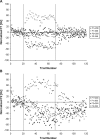Probing the independence of formant control using altered auditory feedback
- PMID: 21361452
- PMCID: PMC3070987
- DOI: 10.1121/1.3531932
Probing the independence of formant control using altered auditory feedback
Abstract
Two auditory feedback perturbation experiments were conducted to examine the nature of control of the first two formants in vowels. In the first experiment, talkers heard their auditory feedback with either F1 or F2 shifted in frequency. Talkers altered production of the perturbed formant by changing its frequency in the opposite direction to the perturbation but did not produce a correlated alteration of the unperturbed formant. Thus, the motor control system is capable of fine-grained independent control of F1 and F2. In the second experiment, a large meta-analysis was conducted on data from talkers who received feedback where both F1 and F2 had been perturbed. A moderate correlation was found between individual compensations in F1 and F2 suggesting that the control of F1 and F2 is processed in a common manner at some level. While a wide range of individual compensation magnitudes were observed, no significant correlations were found between individuals' compensations and vowel space differences. Similarly, no significant correlations were found between individuals' compensations and variability in normal vowel production. Further, when receiving normal auditory feedback, most of the population exhibited no significant correlation between the natural variation in production of F1 and F2.
Figures





References
-
- Abbs, J. H., and Gracco, V. L. (1984). “Control of complex motor gestures: Orofacial muscle responses to load perturbations of lip during speech,” J. Neurophysiol. 51, 705–723. - PubMed
-
- Bernstein, N. A. (1967). The Co-ordination and Regulation of Movements (Pergamon Press, Oxford: ), p. 196.
-
- Browman, C. P., and Goldstein, L. M. (1986). “Towards an articulatory phonology,” Phonol. Yearbook 3, 219–252.10.1017/S0952675700000658 - DOI
Publication types
MeSH terms
Grants and funding
LinkOut - more resources
Full Text Sources
Miscellaneous

